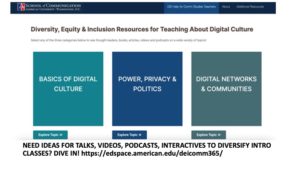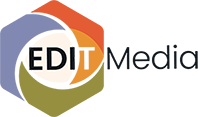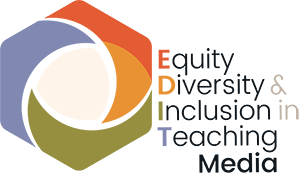by Patricia Aufderheide and Saif Shahin

American University School of Communications’ DEI resources site, image courtesy of Patricia Aufderheide
When our university renewed its commitment to diversity, equity and inclusion two years ago in the wake of George Floyd’s murder, we all had the job to bring that home. But good intentions need to come with resources.
As demonstrators protested throughout the country, indeed the world, we met in American University’s School of Communication to discuss our response. An anti-racist statement, perhaps? We were all tired of statements. And one of our Black professors said, with understandable crispness, “We haven’t done anything yet. Let’s call ourselves anti-racist when we are anti-racist.”
So we decided to act for change appropriate to our position–by developing curriculum that could meet the “diversity, equity and inclusion” designation.
Required.
Our students have to take at least one DEI-designated course before graduating. In Communication Studies, we decided that designating electives alone would be a kind of cheating. If we really thought DEI was important, if in the spirit of Ibram Kendi’s advice that policy change was essential to anti-racism, then we would make sure that a required course would get that designation.
Our Digital Media & Culture course, the gateway to our major, was a natural option. From the digital divide to biased algorithms, Black Twitter and platform job and real-estate ads that deliberately skew to the white and the monied—the field was pervaded, in some ways defined, by DEI questions.
It wasn’t hard to make that argument, to get approval from colleagues in our department, and to have the university’s nod for a syllabus that reflected pretty much our current practice.
But then the real head-scratching began. This course is taught by veteran tenured folks, adjuncts, grad students, everyone. There are multiple sections every semester. How would we be able to help the newbie instructor who got assigned the course two days before class begins? How would we be able to expect buy-in and enthusiasm from our teachers?
Fortunately, our dean had already launched a mini-grant program as part of our unit’s response to Floyd’s killing, offering up to $3,000 for projects that dealt with race.
We decided to apply to create some resources that we could share with other teachers who may not be as familiar with the field, its leading scholars from diverse backgrounds, and the many kinds of media we use to make these issues real to our students. We thought we could donate our time and hire graduate students to help us implement the plan. We got the grant.
Laser-focused.
We knew what we didn’t want: A scholarly bibliography, or general readings on DEI. Such resources exist, but it can be hard to sift for the material you need for the undergraduate classroom. This would be highly structured, and laser-focused on this one course.
We wanted to make ours a resource aimed at the student experience. We wanted materials that you could use in class, or assign to a time-stressed sophomore. So we wanted to create session-sized categories based on how educators would organize a course.
To decide on those categories, we consulted several common texts and our own syllabi, eventually settling on some 19 separate categories, ranging from Citizenship in Digital Society to Mobile Culture to Digital Privacy & Surveillance. And within those categories, we wanted to find short videos, TED talks, podcast episodes, journalistic readings, things undergraduates would respond to. We also wanted sample class exercises.
Also, we wanted it to be ready to use in a just-in-time way. We assumed that by the time someone is turning to the resource, it’s often the day before class, and that’s no time to be reading monographs, even great ones. Using teaching resources is kind of like reading the directions; you do it when all else fails.
At the same time, the teacher does want to know some touchstone names, not only so you can hunt up their TED talk, but also to find out what they’ve said lately, even potentially on a hot-button issue that week, and to use their work as a gateway to new (to you) networks of scholars. So we wanted to provide a few names of leading scholars to follow, people who met some diversity criteria.
To operationalize “diversity” among the scholars we highlighted, we used these general marked categories as a starting point: gender, race/ethnicity, disability, youth, and international (from a U.S. position). Generally, we tried to find leading scholars in two of those categories, but not always. In terms of issues, we were looking at all the ways in which scholars were addressing the consequences of power inequities in digital culture.
Team.
One of us dedicated their graduate assistant’s time to the project; Mariana Sánchez Santos, a Mexican national, was a second-year PhD student, completing her research for comprehensive exams, and eager to use this project to get a better grasp of the field. We also hired a student, an African-American, from our MFA program in film. Marissa Woods brought not only her informed curiosity to the project but superb design skills as well. We met with these dedicated and creative grad students every two weeks, to assess, between January and June. We often threw out names of scholars, podcasts, movies, etc., as entry points, and we iterated the design as it moved from an informal Google doc to the online platform.
As the design evolved, we saw the importance of having good graphics and visuals associated with the elements, not only because they were appealing, but because they provided so much information so quickly. We began to appreciate the value of having a good designer working from within the project, trying out different ways to attract and keep attention.
The entire project was built in Canvas, the learning management system that American University uses. It was simply structured, as a set of 19 modules. Having it on Canvas meant that our many teachers for the course could all access it, not only to use materials but, crucially, to contribute to them.
Going public.
We were almost done with this when we realized that from within Canvas we would be unable to share this work with anyone outside the university. Not only that, we couldn’t even share it with staff. We begged some space from a university website created by our School of Education, to mirror the Canvas site. And our graduate students heroically ported over manually the entire 19 modules, then grouping those 19 into three mini-portals on the landing page.
The website was ready by the first day of orientation week. And we got to debut it not only for our own faculty but for the entire university, because we won a curriculum design award for this work! And our dean was so inspired by our design that he created another mini-grant program for other departments in our school to come up with DEI teaching resources for other required courses.
This resource is brand new, and very much a first iteration. This is also the first semester we’re using this, and we hope to get feedback, suggestions and additions from our faculty and others. We shared the link with our professional associations, and the response so far has been kind. We created an email account, DEIresourcesAU@gmail.com, for more feedback.
We couldn’t have done it without the university’s institutional commitment to requiring students to take DEI-labelled courses, and without our school’s mini-grant. But now we don’t have any funding to expand the Canvas site, other than our profs’ own donations. And our public-facing website is static. So at the moment our fondest hope is just that the model of this project inspires other people to do similar work, and we can learn from them. We also hope to raise some funds to do maintenance on this and other sites within our School of Communication.
As our colleagues in the Maintainer scholarly community say, maintenance is as important as innovation. And DEI resources, much like DEI principles, don’t maintain themselves.
Patricia Aufderheide is University Professor in the School of Communication at American University. She founded the School’s Center for Media & Social Impact, where she continues as Senior Research Fellow. Aufderheide specializes in the social impact of mass media and communication policies.She co-authored, with Peter Jaszi, Reclaiming Fair Use: How to Put Balance Back in Copyright (University of Chicago Press, 2011) and authored Documentary Film: A Very Short Introduction (Oxford University Press, 2007)
Saif Shahin is Assistant Professor in the School of Communication at American University and a Faculty Fellow with the Internet Governance Lab. He is also an Associate Editor at the Journal of Information Technology and Politics. His scholarship focuses on critical data studies, social computing, global media and politics, and media sociology, and is underpinned by a normative commitment to social justice.


Join the discussion One Comment